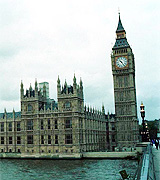 A Celtic city that was later fortified by the Romans
who used it as their harbour on the river Thames. All the Kings of England were
crowned in Westminster Abbey from the Middle Ages onwards. With the passing
of time, London’s financial district (the City of today) grew up on the
remains of the old Roman settlement and the rest of the city gradually spread
out in all directions from here. It was the capital of the British Empire from
the 16th century until the first half of the 20th century. The Great Fire of
1666 destroyed much of the City and its reconstruction took about ten years.
Christopher Wren designed many of its great monuments, rebuilding some of the
destroyed churches, including St. Paul's Cathedral. London was the largest city
in the world in the 18th and early 19th centuries. The Metropolitan Board of
Works was set up in 1855 to superintend the construction of the necessary infrastructures.
The MBW was closed in 1889 and replaced by the County of London, governed by
London County Council. London was bombed by the Luftwaffe during the Second
World War. The air raids killed many Londoners and destroyed various parts of
the city, which were all rebuilt after the war. The expansion of London slowed
down considerably during the Second World War thanks to the adoption of various
town-planning schemes. Until 1997, London was also a regular target for IRA
bomb attacks in an attempt to force the British Government to negotiate with
the Sinn Féin in Northern Ireland. A Celtic city that was later fortified by the Romans
who used it as their harbour on the river Thames. All the Kings of England were
crowned in Westminster Abbey from the Middle Ages onwards. With the passing
of time, London’s financial district (the City of today) grew up on the
remains of the old Roman settlement and the rest of the city gradually spread
out in all directions from here. It was the capital of the British Empire from
the 16th century until the first half of the 20th century. The Great Fire of
1666 destroyed much of the City and its reconstruction took about ten years.
Christopher Wren designed many of its great monuments, rebuilding some of the
destroyed churches, including St. Paul's Cathedral. London was the largest city
in the world in the 18th and early 19th centuries. The Metropolitan Board of
Works was set up in 1855 to superintend the construction of the necessary infrastructures.
The MBW was closed in 1889 and replaced by the County of London, governed by
London County Council. London was bombed by the Luftwaffe during the Second
World War. The air raids killed many Londoners and destroyed various parts of
the city, which were all rebuilt after the war. The expansion of London slowed
down considerably during the Second World War thanks to the adoption of various
town-planning schemes. Until 1997, London was also a regular target for IRA
bomb attacks in an attempt to force the British Government to negotiate with
the Sinn Féin in Northern Ireland.
|

